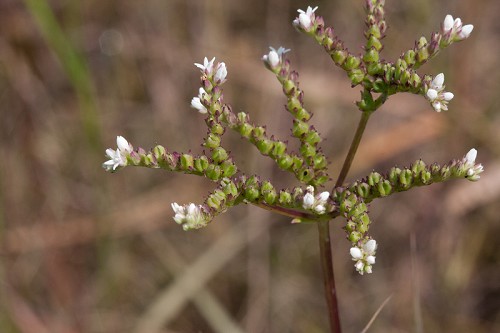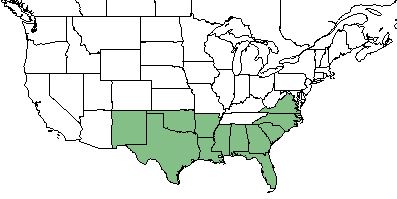Difference between revisions of "Mitreola sessilifolia"
HaleighJoM (talk | contribs) (→Ecology) |
|||
| (3 intermediate revisions by 3 users not shown) | |||
| Line 32: | Line 32: | ||
==Ecology== | ==Ecology== | ||
===Habitat=== <!--Natural communities, human disturbed habitats, topography, hydrology, soils, light, fire regime requirements for removal of competition, etc.--> | ===Habitat=== <!--Natural communities, human disturbed habitats, topography, hydrology, soils, light, fire regime requirements for removal of competition, etc.--> | ||
| − | ''M. sessilifolia'' is found in wet savannas, pocosins, ditches, and margins of limesink depressions (dolines).<ref name= "Weakley 2015"> Weakley, A. S. (2015). Flora of the Southern and Mid-Atlantic States. Chapel Hill, NC, University of North Carolina Herbarium. </ref> Specimens have been collected from moist loamy sand, wet ditches, oak woods, pine flatwoods, border of swampy woodlands, longleaf pine wiregrass, savannas, sandy peat of slash pines, floodplain marshes, sinkhole pondshores, wet pinelands, frequently-burned hillsides of seepage bogs, pine-gum woodlands, and along streams.<ref name = "FSU herbarium"> URL: http://herbarium.bio.fsu.edu. Last accessed: June 2018. Collectors: Loran C. Anderson, R.A> Norris, R.F. Doren, R.K. Godfrey, R. Komarek, Cecil Slaughter, S.W. Leonard, R.E. Perdue, R. Kral, Victoria Sullivan, Richard Houk, Robert J. Lamaire, George R. Cooley, Carroll E. Wood Jr., Kenneth A. Wilson, Leonard J. Brass, Steve Orzell, Edwin L. Bridges, James D. Ray, Sidney McDaniel, S.B. Jones, A.B. Seymour, D.S. Correll, E. C. Ogden, H.K. Svenson, A.E. Radford, P. Sheridan, Jeffery M. Kane, William Platt. States and counties: Florida (Liberty, Leon, Franklin, Santa Rosa, Flagler, Monroe, Jefferson, Levy, Brevard, Okaloosa, Orange, Bay, Palm Beach, St. Johns, Okeechobee, Indian River, Citrus, Calhoun, COllier, Gulf, Walton, Okaloosa, Martin, Lee, Nassau, Holmes) Georgia (Thomas, Grady, Berrien, Tattnall, Baker, Colquitt) Alabama (Mobile, Washington, Monroe) Mississippi (Lamar, Greene, Jackson, George) North Carolina (Onslow) South Carolina (Williamsburg) Texas (Jasper, Hardin) </ref> ''M. sessilifolia'' | + | ''M. sessilifolia'' is found in wet savannas, pocosins, ditches, and margins of limesink depressions (dolines).<ref name= "Weakley 2015"> Weakley, A. S. (2015). Flora of the Southern and Mid-Atlantic States. Chapel Hill, NC, University of North Carolina Herbarium. </ref> Specimens have been collected from moist loamy sand, wet ditches, oak woods, pine flatwoods, border of swampy woodlands, longleaf pine wiregrass, savannas, sandy peat of slash pines, floodplain marshes, sinkhole pondshores, wet pinelands, frequently-burned hillsides of seepage bogs, pine-gum woodlands, and along streams.<ref name = "FSU herbarium"> URL: http://herbarium.bio.fsu.edu. Last accessed: June 2018. Collectors: Loran C. Anderson, R.A> Norris, R.F. Doren, R.K. Godfrey, R. Komarek, Cecil Slaughter, S.W. Leonard, R.E. Perdue, R. Kral, Victoria Sullivan, Richard Houk, Robert J. Lamaire, George R. Cooley, Carroll E. Wood Jr., Kenneth A. Wilson, Leonard J. Brass, Steve Orzell, Edwin L. Bridges, James D. Ray, Sidney McDaniel, S.B. Jones, A.B. Seymour, D.S. Correll, E. C. Ogden, H.K. Svenson, A.E. Radford, P. Sheridan, Jeffery M. Kane, William Platt. States and counties: Florida (Liberty, Leon, Franklin, Santa Rosa, Flagler, Monroe, Jefferson, Levy, Brevard, Okaloosa, Orange, Bay, Palm Beach, St. Johns, Okeechobee, Indian River, Citrus, Calhoun, COllier, Gulf, Walton, Okaloosa, Martin, Lee, Nassau, Holmes) Georgia (Thomas, Grady, Berrien, Tattnall, Baker, Colquitt) Alabama (Mobile, Washington, Monroe) Mississippi (Lamar, Greene, Jackson, George) North Carolina (Onslow) South Carolina (Williamsburg) Texas (Jasper, Hardin) </ref> |
| + | |||
| + | ''M. sessilifolia'' decreased its occurrence or was unaffected in response to soil disturbance by roller chopping in south Florida. It either exhibited regrowth or was unaffected by reestablished native habitat that was disturbed by this practice.<ref>Lewis, C.E. (1970). Responses to Chopping and Rock Phosphate on South Florida Ranges. Journal of Range Management 23(4):276-282.</ref> | ||
''Mitreola sessilifolia'' is an indicator species for the Calcareous Savannas community type as described in Carr et al. (2010).<ref>Carr, S.C., K.M. Robertson, and R.K. Peet. 2010. A vegetation classification of fire-dependent pinelands of Florida. Castanea 75:153-189.</ref> | ''Mitreola sessilifolia'' is an indicator species for the Calcareous Savannas community type as described in Carr et al. (2010).<ref>Carr, S.C., K.M. Robertson, and R.K. Peet. 2010. A vegetation classification of fire-dependent pinelands of Florida. Castanea 75:153-189.</ref> | ||
| Line 40: | Line 42: | ||
<!--===Seed dispersal===--> | <!--===Seed dispersal===--> | ||
<!--===Seed bank and germination===--> | <!--===Seed bank and germination===--> | ||
| − | + | ||
| + | ===Fire ecology=== <!--Fire tolerance, fire dependence, adaptive fire responses--> | ||
| + | Populations of ''Mitreola sessilifolia'' have been known to persist through repeated annual burning.<ref>Platt, W.J., R. Carter, G. Nelson, W. Baker, S. Hermann, J. Kane, L. Anderson, M. Smith, K. Robertson. 2021. Unpublished species list of Wade Tract old-growth longleaf pine savanna, Thomasville, Georgia.</ref> | ||
<!--===Pollination===--> | <!--===Pollination===--> | ||
| − | <!--=== | + | <!--===Herbivory and toxicology===--> |
| − | <!--==Diseases and parasites==--> | + | <!--===Diseases and parasites===--> |
==Conservation, cultivation, and restoration== | ==Conservation, cultivation, and restoration== | ||
Latest revision as of 15:39, 14 July 2022
Common name: swamp hornpod[1], small-leaved miterwort[2]
| Mitreola sessilifolia | |
|---|---|

| |
| Photo from the Southeastern Flora Database | |
| Scientific classification | |
| Kingdom: | Plantae |
| Division: | Magnoliophyta - Flowering plants |
| Class: | Magnoliopsida - Dicots |
| Order: | Gentianales |
| Family: | Loganiaceae |
| Genus: | Mitreola |
| Species: | M. sessilifolia |
| Binomial name | |
| Mitreola sessilifolia J.F. Gmelin | |

| |
| Natural range of Mitreola sessilifolia from USDA NRCS Plants Database. | |
Contents
Taxonomic Notes
Synonyms: Cynoctonum sessilifolium J.F. Gmelin.[3]
Varieties: none.[3]
Description
M sessilifolia is an annual forb/herb of the Loganiaceae family native to North America.[1] It's leaves are sessile, rounded at the base, and 1.5-2x as long as wide. Mature seeds are smooth and the capsule is papillose-warty.[3]
Distribution
M. sessifolia ranges from southeast Virginia to Florida and west to east Texas. It's also found in the Bahamas.[3]
Ecology
Habitat
M. sessilifolia is found in wet savannas, pocosins, ditches, and margins of limesink depressions (dolines).[2] Specimens have been collected from moist loamy sand, wet ditches, oak woods, pine flatwoods, border of swampy woodlands, longleaf pine wiregrass, savannas, sandy peat of slash pines, floodplain marshes, sinkhole pondshores, wet pinelands, frequently-burned hillsides of seepage bogs, pine-gum woodlands, and along streams.[4]
M. sessilifolia decreased its occurrence or was unaffected in response to soil disturbance by roller chopping in south Florida. It either exhibited regrowth or was unaffected by reestablished native habitat that was disturbed by this practice.[5]
Mitreola sessilifolia is an indicator species for the Calcareous Savannas community type as described in Carr et al. (2010).[6]
Phenology
M. sessilifloria flowers from late June to August and fruits from September through October.[3]
Fire ecology
Populations of Mitreola sessilifolia have been known to persist through repeated annual burning.[7]
Conservation, cultivation, and restoration
Cultural use
Photo Gallery
References and notes
- ↑ 1.0 1.1 USDA Plant Database https://plants.usda.gov/core/profile?symbol=MISE3
- ↑ 2.0 2.1 Weakley, A. S. (2015). Flora of the Southern and Mid-Atlantic States. Chapel Hill, NC, University of North Carolina Herbarium.
- ↑ 3.0 3.1 3.2 3.3 3.4 Weakley, A.S. 2015. Flora of the southern and mid-atlantic states. Working Draft of 21 May 2015. University of North Carolina at Chapel Hill, Chapel Hill, North Carolina.
- ↑ URL: http://herbarium.bio.fsu.edu. Last accessed: June 2018. Collectors: Loran C. Anderson, R.A> Norris, R.F. Doren, R.K. Godfrey, R. Komarek, Cecil Slaughter, S.W. Leonard, R.E. Perdue, R. Kral, Victoria Sullivan, Richard Houk, Robert J. Lamaire, George R. Cooley, Carroll E. Wood Jr., Kenneth A. Wilson, Leonard J. Brass, Steve Orzell, Edwin L. Bridges, James D. Ray, Sidney McDaniel, S.B. Jones, A.B. Seymour, D.S. Correll, E. C. Ogden, H.K. Svenson, A.E. Radford, P. Sheridan, Jeffery M. Kane, William Platt. States and counties: Florida (Liberty, Leon, Franklin, Santa Rosa, Flagler, Monroe, Jefferson, Levy, Brevard, Okaloosa, Orange, Bay, Palm Beach, St. Johns, Okeechobee, Indian River, Citrus, Calhoun, COllier, Gulf, Walton, Okaloosa, Martin, Lee, Nassau, Holmes) Georgia (Thomas, Grady, Berrien, Tattnall, Baker, Colquitt) Alabama (Mobile, Washington, Monroe) Mississippi (Lamar, Greene, Jackson, George) North Carolina (Onslow) South Carolina (Williamsburg) Texas (Jasper, Hardin)
- ↑ Lewis, C.E. (1970). Responses to Chopping and Rock Phosphate on South Florida Ranges. Journal of Range Management 23(4):276-282.
- ↑ Carr, S.C., K.M. Robertson, and R.K. Peet. 2010. A vegetation classification of fire-dependent pinelands of Florida. Castanea 75:153-189.
- ↑ Platt, W.J., R. Carter, G. Nelson, W. Baker, S. Hermann, J. Kane, L. Anderson, M. Smith, K. Robertson. 2021. Unpublished species list of Wade Tract old-growth longleaf pine savanna, Thomasville, Georgia.